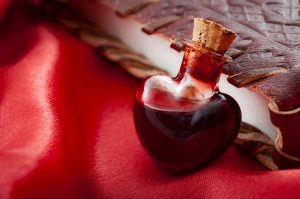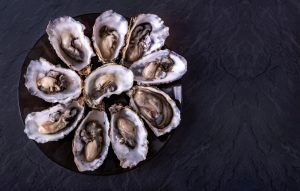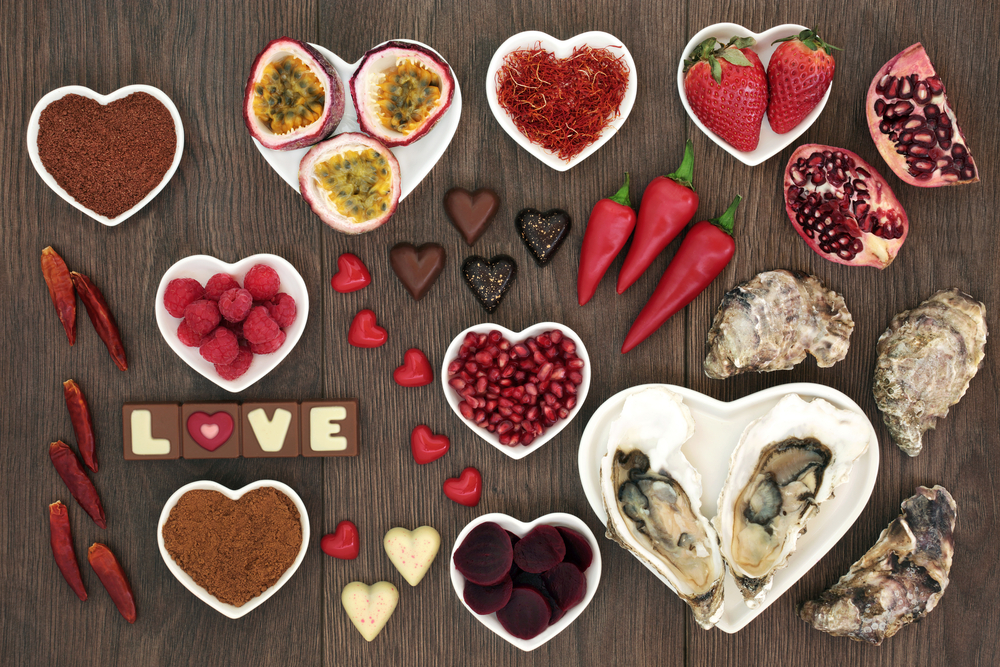As defined by the Oxford English Dictionary, aphrodisiac pertains to any “food, drink, or drug that arouses sexual desire.” Although this broad description can encompass a multitude of substances, aphrodisiacs are mostly identified in the form of herbs, tonics, or potions.
History shows us how certain foods have an impact on different bodily functions. Specifically, aphrodisiacs improve sexual performance in many ways—increasing sexual desire, enhancing one’s stamina, and encouraging genital stimulation, to name a few.
Long before Viagra existed, traditional aphrodisiacs were there first. The purported benefits of aphrodisiacs have been popular since ancient times. Particularly common in the prehistoric medical practices of Greek, Roman, Indian, Chinese, and Egyptian civilizations, aphrodisiacs can be likened to a gift sent from the gods. For this reason, one should note the relevance of the Greek origin of aphrodisiac—”aphros.” The name of these sexually stimulating substances is, in fact, derived from the Greek goddess of beauty and love, Aphrodite. Interestingly, the meaning of aphros in Greek is “foam,” which perfectly summarizes the bizarre creation of Aphrodite. After Zeus’ father Cronus cut off the genitals of Uranus, Zeus’ grandfather and Cronus’ father, the castrated genital was thrown to the sea, which became the foam where Aphrodite was formed.
Examples of Aphrodisiacs
 Achieving optimum sexual satisfaction can be attained by consuming a wide variety of herbal and animal extracts. This ranges from herbs generally accepted in modern alternative medicine to unusual and lesser-known ones. An 8th-century text containing the ancient Sanskrit medicinal practices called Samhita of Sushruta indicated some of the strangest and perhaps disgusting practices. For instance, boiling clarified butter along with the testes or eggs of frogs, mice, sparrows, and even alligators are a fad back then. In continuation, it was also widely believed that rubbing the boiled animal extract on one’s soles of the feet gives any man a stamina boost in bed but with a price: the man’s feet should not touch the ground otherwise, it will lose their efficacy.
Achieving optimum sexual satisfaction can be attained by consuming a wide variety of herbal and animal extracts. This ranges from herbs generally accepted in modern alternative medicine to unusual and lesser-known ones. An 8th-century text containing the ancient Sanskrit medicinal practices called Samhita of Sushruta indicated some of the strangest and perhaps disgusting practices. For instance, boiling clarified butter along with the testes or eggs of frogs, mice, sparrows, and even alligators are a fad back then. In continuation, it was also widely believed that rubbing the boiled animal extract on one’s soles of the feet gives any man a stamina boost in bed but with a price: the man’s feet should not touch the ground otherwise, it will lose their efficacy.
In traditional Chinese medicine, a 2600 BCE document known as Huang-Ti Nei-Ching where a 22-ingredient aphrodisiac potion was recorded. According to the document, this potion helped an emperor achieve immortality that he was able to mount on 1200 women. Staggering.
There are plenty of other popular aphrodisiacs used in specific regions of the world. Some of these are:
- In ancient Egypt, it was a common practice to rub the male genitalia with a crocodile heart mixture.
- A Greek philosopher named Pliny likened the appearance of mandrake root to the female genitals. This characteristic made the philosopher associate this herb with improving vigor.
- Consuming the reproductive organs of animals can be considered a custom among the ancient Chinese people.
- During medieval times, the Romans believed that enhancing and maintaining a vigorous sex drive can be attained by ingesting the semen of young men. The youthful qualities of these men are also thought to be present in their seminal fluid—that is, the active physical nature of young men is transferred when consumed.
- In Sardinia, casu marzu or rotting cheese covered with maggots is a known aphrodisiac despite it being repulsing.
- Although this fruit is popular, if not notorious, for its overpowering unpleasant scent, durian is one of the highly sought-after aphrodisiacs in Southeast Asia.
- Amidst all the scientific proof contradicting this claim, crushed rhino horns remain to be a popular commodity for improving the virility of men in Africa.
- Since Aphrodite was believed to be born out of seafoam, most seafood and shellfish were claimed to be aphrodisiacs. Among the most well-known of this variety are oysters.
Do Aphrodisiacs Work?
Only a few of the known historical aphrodisiacs have solid scientific proofs to back these claims. In this article, four modern aphrodisiacs will be examined in terms of their scientific benefits.
Oysters
 West (2015) reported that Casanova himself admitted that for him to preserve his youthful virility and stamina, he consumes 50 raw oysters for breakfast. Although this sounds too good to be true, this health benefit is thoroughly studied—scientific researches produced findings in favor of these bivalve mollusks. Oysters are highly valuable due to their high zinc content. It is precisely because of zinc that gives oysters their aphrodisiac quality. The essential mineral influences the overall health of the male reproductive system. Males with high levels of zinc have better sperm production and quality. Apart from zinc, Roshanzamir (2017) stated that two amino acids called D-aspartic acid and N-methyl D-aspartic acid (NMDA) also contribute to raising the level of sex hormones in animals.
West (2015) reported that Casanova himself admitted that for him to preserve his youthful virility and stamina, he consumes 50 raw oysters for breakfast. Although this sounds too good to be true, this health benefit is thoroughly studied—scientific researches produced findings in favor of these bivalve mollusks. Oysters are highly valuable due to their high zinc content. It is precisely because of zinc that gives oysters their aphrodisiac quality. The essential mineral influences the overall health of the male reproductive system. Males with high levels of zinc have better sperm production and quality. Apart from zinc, Roshanzamir (2017) stated that two amino acids called D-aspartic acid and N-methyl D-aspartic acid (NMDA) also contribute to raising the level of sex hormones in animals.
Chocolate
There is a reason behind the popularity of chocolates as gifts every Valentine’s Day—it acts as a mood enhancer and an aphrodisiac. Although it is scientifically proven that the cocoa in dark chocolates possesses nutrients beneficial to cardiovascular health, not much is known about the aphrodisiac quality of chocolate.
In a study centered on 153 North Italian women, the effect of chocolate on the Female Sexual Function Index (FSFI) was examined. This involved comparing two groups of women: one group regularly consumed chocolates every day while the other did not. According to Salonia (2006), the initial claims and the findings of the research did not match. Unfortunately, there is not much significant difference in terms of sexual function between the two groups.
Chili peppers
What makes chili peppers distinct from the other non-spicy variants of peppers is their capsaicin content. Capsaicin is responsible for giving chili peppers their hot flavor and medicinal properties. Not only that, but the heat in capsaicin is also associated with the heightened sensations involved in arousal and sexual potency. Facial flushing, the increase of heart rate, and sweating—all of these are the effects of sexual arousal and consuming capsaicin.
Conflicting research findings have made it impossible to determine the status of chili peppers as an aphrodisiac. One study showed that although chili peppers positively influenced the frequency of ejaculation in rats, the ejaculation of the test subjects was premature. Pelayo (2017) stated that male rats exhibit improved sexual behavior and reduced duration in between ejaculations. However, the only noted downside of this is premature ejaculation.
Red ginseng and maca
Both red ginseng and maca are herbs linked to sexual function. Whereas red ginseng helps in erectile dysfunction, as stated by Jang (2008), maca, on the other hand, is a Peruvian root that increases sexual desire. However, studies on these herbs are insufficient to determine solid conclusions—albeit the potential is promising.
Dietary supplementation may be an optimal way for men to get the necessary androgenic and adaptogenic benefits of these proven aphrodisiacs. One of the top testosterone-boosting formulas pack superior extracts of over 12 natural ingredients proven to boost testosterone levels in Male UltraCore. Male UltraCore is powered by proprietary technologies designed to raise your T for better fertility, energy, vigor, and performance. Furthermore, Male UltraCore boasts only the purest, most potent, and safest standardized ingredient extracts that puts it in a class of its own. No other testosterone booster supplement is as packed as Male UltraCore is when it comes to raising your overall performance at any age. If you suspect that you might have low T, or if your doctor has diagnosed you, consider talking to them about Male UltraCore.



